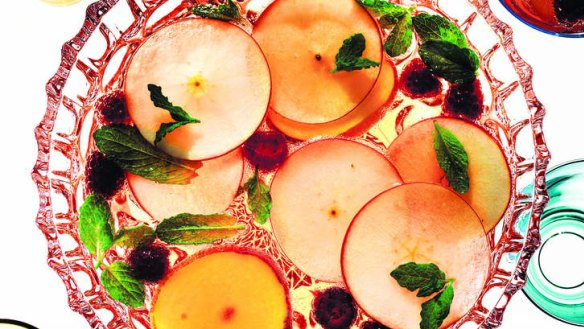Why you should serve traditional punch this Christmas

Punch is a drink that, despite efforts in recent years by some of the cocktail world's hippest inhabitants, remains a bit of a joke. First there's the rumpus room, kabana and faux cut-glass bowl connotations. Then there's the debauched share-house party persona, usually involving a plastic rubbish bin, vast quantities of the cheapest booze available and the possibility that someone slipped LSD onto the ever-evolving list of ingredients. And, of course, there's the name itself with its potentially prophetic meaning.
But classic punch has an elegant history and an almost poetic formula. When made by the traditional book, it's a seriously fine way to get a party ticking over without the guests getting hammered too quickly.
One of the things to remember about punch is that it's not a giant cocktail. Cocktails are much heftier and can become cloying and completely inebriating. Classic punch is a subtler beast, a purposely diluted "session" drink that will not knock your socks off after number two.
History points to punch originating in India. Punch is, in fact, a slightly Anglicised form of the Sanskrit word meaning "five". The Indian drink was called this because it was made with five ingredients - a base alcohol, sugar, lemon, water and either tea or spices - that balanced weak, strong, bitter, sour and sweet. Poetry in a punchbowl.
It was in this form that punch was imported into England in the mid-1600s. Over the next couple of centuries it became hugely popular (taverns that served punch often had as many punch bowls as they had tables) and a great favourite of literary types from Dryden and Defoe through to Dickens, who both wrote about and made his own punch.
During this time, the five elements remained, though the base spirit, originally brandy or wine, changed with the arrival of rum from Jamaica. The British, never a race to hold back when there are drinks to be had, also began to play with the formula, tweaking it to suit a wider variety of occasions.
Cups, for example, were traditionally served to hunting parties before they set off to slaughter foxes. The most famous of these punches is the Pimm's Cup - a mix of one part Pimm's No.1 to two parts lemonade, a slug of lemon juice, apple, lemon and cucumber slices and, if you can be bothered, a scattering of borage flowers as a final garnish. Lower in alcohol than traditional punch (couldn't have everybody falling off their horses) it's also a good one to serve if you're having a bunch of people over for an afternoon barbecue.
For those after something slightly heftier and more classic, Fish House Punch is a good option. This punch originated in the United States and mixes two parts dark rum (a part in this formula being roughly equivalent to a litre) to one part cognac, one part lemon juice, two parts water and a couple of hefty slugs of peach brandy. You also need to dissolve 1½ cups of sugar in the lemon juice before mixing it all together.
It is important to keep your punch cold. Room temperature is no one's idea of a good time. Firstly, refrigerate all your ingredients before you make the punch (or make it before the guests arrive and shove it in the fridge for a couple of hours). Secondly serve it with the biggest whole block of ice you can find. If all else fails, freeze water in a mixing bowl (run some warm water on the outside of the bowl to loosen it) and use that as your mega-block.
Getting to the bottom of a punch bowl is a communal activity that should take time and leave the party convivial and not completely inebriated. Best to favour Dickens over the rubbish bin.
